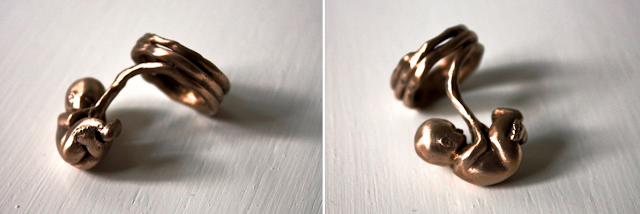A symbol is most
often defined as a recognizable shape or sign used to communicate or
express a
specific object, function or idea. I have chosen to represent the relationship between a mother and her unborn child in the form of a young fetus that sits in the palm of a
mother’s
hand; the child is grasping onto her umbilical cord, her lifeline, which
travels up the mother’s palm and wraps tightly around the mother’s
finger. This ring is meant to be a symbolic
representation of the decision a mother makes in choosing to give her
child
life. Visually, the ring is not
entirely seen by an outside viewer, as the fetus remains safely and
intimately
in the palm of the mother’s hand, just as an unborn child remains safely
in its
mother’s womb.
Over the course of the past few months I've had several people ask me about the process of lost wax casting and so I've done a brief photo documentation to display how this process is carried out.
The following images outline the steps I have taken to create this particular article of jewellery. The first step is to model a small sculpture, in wax, of the design one has chosen to work with. The wax be manipulated with one's own hands, heat and small sculpting tools. It is important that one works as clean as possible, as every hair and fingerprint will be cast back in metal.
Once one is satisfied with the wax sculpture, wax sprues are placed on the model to create a passage by which molten metal can travel while casting. The sprues are than adhered to a base with wax and a flask is placed around the base to prepare for investment (the photo below displays a different project I have made but uses the same
process). Investment is then mixed and poured into the flask until level with the top of the cylinder. The flask is then placed on a "bouncing" investment table that releases any air that may be trapped inside, which results in bubbles rising to the surface. After the investment has dried, the base is removed and the flask is placed in a kiln which burns out the wax model, leaving a hollow mold of where the wax used to be. Based on the weight of the wax model, mathematical formulas are utilized to calculate how much metal is required to fill this mold. Once this calculation has been made, a specific amount of metal (bronze in this case) is placed in a crucible with a sprinkle of borax (a chemical used to prevent oxides from forming while heating the metal). The flask is placed in a casting machine and the metal is heated with an oxy acetylene torch. Once the metal has become molten, centrifugal force is used to direct the molten metal into the cavity of the mold for approximately three minutes, depending on the size of one's piece. The flask is set aside until cool, then quenched in water releasing the investment, and one is left with a bronze replica of their wax model.
The cast metal is often covered in dirty oxides and leftover investment which can be cleaned off with hot steam or placed in an ultrasonic (a cleaning device that uses ultrasound (usually from 20-400 kHz) to clean delicate items). Once the surface of the metal is relatively clean, the sprues are cut off and one is left with an object as displayed below. Some of the edges are quite rigid from where the sprues had resided which can be manipulated with files and various rotary tools.
The entire piece is than cleaned and finished with various rotary tools and emery paper to remove scratches and burrs that may have occurred while filing. I have chosen to finish this particular piece with a satin buff.







No comments:
Post a Comment